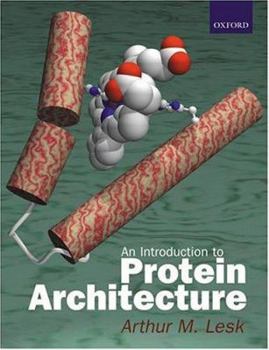Introduction to Protein Architecture: The Structural Biology of Proteins
Written in a clear and engaging style, and profusely illustrated with superb computer graphics, Introduction to Protein Architecture is a textbook for second and third year undergraduate students and beginning post-graduate students, and will be of interest to all biological and medical scientists whose work touches on proteins. The structures and functions of proteins unlock the secrets inherent in genomes, including the human genome. The emphasis of this book is on protein architecture, on proteins as three-dimensional patterns. A new field, bioinformatics, has grown up around gene and protein sequences and structures. It has captured the interest of many scientists for its intellectual challenges, its potential for useful applications, and promising scope for careers. This book introduces the use of the World Wide Web in bioinformatics. Written by one of the leaders in this field, Introduction to Protein Architecture explains the general characteristics of proteins that underlie the very great variety of folding patterns observed in nature. For specialists in structural biology, it contains the core of what they need to know. For students and workers in related disciplines, undergraduates or beginning graduate students in biology, chemistry, medicine, bioinformatics, and related fields it contains what they will be able to apply to their own work. Topics treated include: Pattern and form in protein structure; The building blocks; The relationship between amino acid sequence and protein structure; Secondary, supersecondary and tertiary structure; Classifications and hierarchies of protein folding patterns; Protein evolution; How proteins change conformation (and why). To suit the needs of courses, each chapter includes recommended reading, lists of useful web sites, traditional exercises, and a new type of exercise called a weblem, for WEB-based probLEM.
Format:Paperback
Language:English
ISBN:0198504748
ISBN13:9780198504740
Release Date:January 2001
Publisher:Oxford University Press, USA
Length:360 Pages
Weight:2.80 lbs.
Dimensions:0.7" x 7.5" x 9.6"
Customer Reviews
2 ratings
A nice introduction to structural biology
Published by Thriftbooks.com User , 21 years ago
This book deserves 5 stars on the basis of its color stereo diagrams alone! Well done. I wish I had this book when I was starting out as a graduate student! A very good explanation of structural hierarchy. Plus the book also contains excellent details of structure of proteins belonging to specific families -for ex., antibodies. Even today, for my work, I find it very convenient to look into the book first for some structural information rather than into the PDB databases. And yes, I do have a very good pair of stereo glasses always on hand!
If Frank Lloyd Wright did proteins...
Published by Thriftbooks.com User , 24 years ago
This is truly a monument to the architecture of proteins: a gorgeous tour of the structures that dwell within us. The "frozen music" of biology is clearly presented in beautiful detail. The computer-generated renderings give pause to anyone who wonders what God was up to when She thought about creating life. Proteins, as represented here, are Her finest efforts. Visually stunning is only the most obvious aspect of this amazing introduction to structural genomics (proteinomics): the systematic study of protein structures. This is a serious graduate level textbook. The text should be considered for any introductory graduate level course in biochemistry. Beginning with sound chemical principles, the text lays a solid foundation for the concepts of secondary and tertiary structure within protein. The author builds a superstructure from which to view the motifs of cofactor binding domains and active sites in enzymes. Each chapter concludes with exercises, problems and "weblems". The weblems underscore the fact that structural genomics, a branch of bioinformatics, is a hot topic in the biotech arena. The weblems ask the reader to pursue ideas on the world wide web. The author provides the reader with a wealth of websites ranging from browser plug-in software for viewing crystal structures, to sources of those structures, to sequence alignment servers which will allow the student to do real research. Well thought-out, the weblems posed are useful to the student in exploring the topics of each chapter. The author sticks to protein architecture avidly, issues of how proteins fold or how structure might be predicted from amino acid sequence are presented to the reader. It is a credit to the author that he does not speculate on these very hot research topics. The bibiliography for each chapter is current to mid-2000. A student using this text will have greater insight and understanding of the literature of protein structure, folding, and prediction of structure. This book would also be a useful reference to the veteran practitioner, summarizing an early 21st century look at this field.





